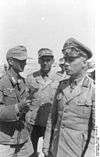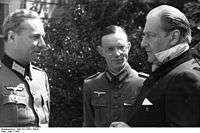Sonderführer
- This article incorporates information from the equivalent article on the German Wikipedia.
Sonderführer (short: Sdf | or Sf = Sonderführer with military command power German: Sonderführer mit militärischer Kommandobefugnis) – in the meaning of specialist leader (literal: special leader) – was the function assignment, introduced in the Wehrmacht of Nazi Germany in 1937.[1]
It was established for the mobilization of the German armed forces. With the draft of Sonderführer to military service, the competence of civil experts and specialists could be exploited. Certain assignments from senior officers, company-grade officers, up to non-commissioned officer (NCO) ranks could be filled. A huge variation of service functions, e.g. in foreign languages, propaganda work, medical service, veterinary service and the like, was possible. Typically, the men were not trained as soldiers. They received the pay applicable to the position they were holding, but only by virtue of their temporary appointment. As a rule, Sonderführer were not allowed to execute the command and disciplinary powers vested in the rank. However, this was changed in 1942, during World War II.
Sonderführer were used not only in Wehrmacht and Waffen-SS, but also in other Nazi-organisation, e.g. in the Organisation Todt, Reichsarbeitsdienst, etc.
In soldier´s slang Sonderführers, as well as Wehrmacht´s officials (de: Wehrmachtsbeamte) and military chaplains, were called narrow-gauge officers (de: Schmalspuroffiziere).
Categories of Sonderführer
Draftees were called up for Sonderführer to almost all branches of service (Heer, Luftwaffe and Kriegsmarine) or special forces, equivalent to assignments or appointment of military personnel in the hierarchy of the Wehrmacht.
- Officer function assignments in the hierarchy of the Heer (Army)
- Sonderführer (B) , equivalent to Major / Oberstleutnant (OF-3/-4),
- Sonderführer (K) , equivalent to Hauptmann or Rittmeister (OF-2),
- Sonderführer (Z) , equivalent to Leutnant / Oberleutnant (OF-1) or Platoon leader.
- NCO function assignments in the hierarchy of the Heer (Army)
- Sonderführer (O) , also Dolmetscher O (en: Interpreter O), equivalent to an Oberfeldwebel (OR-7),
- Sonderführer (G) , equivalent to an Unteroffizier (OR-4).
Sonderführer were mainly deployed:
- As interpreter
- In construction engineering
- In the field of public finance, and administration tasks
- To handle scientific tasks, e.g. as Archaeology or Curator
- In the field of agriculture science
- Railway transport, in particular field railways
In case of professional expertise as photograph or draughtsman, the appropriate draftee could be called up for Sonderführer to a so-called Propaganda unit of the Wehrmacht.
An example of individual influence to the occupied territory, in this situation to the language, approves the case of Sonderführer Leo Weisgerber. He authoritative initiated a champagne to unify the Breton: language. Up to the present time there are after-effects to this in the particular French region Brittany[2]
Position and status
Sonderführer were called up to military service to use the skills and expertise of specialists on defined function positions. This status was limited as to time, and became revocable if a military trained soldier could fill this position. In this case, the Sonderführer was fit in to the "regular" military training procedure etc. The former function position as Sonderführer – which contained a service "assignment" not including a service "grade" – remained without consideration.
By order in 1942 – Sonderführer on officer assignments received regular military training, in order to join the reserve officer corps. Therefore, the limitations to execute military command – and disciplinary powers were lifted.[3]
In soldier´s slang Sonderführers, as well as Wehrmacht´s officials (de: Wehrmachtsbeamte) and army chaplains (de: Militärpfarrer), were called narrow-gauge officers (de: Schmalspuroffiziere).
The legal state of the Sonderführer was equivalent to those of a soldier in the meaning of the Nazi Service Act Legislation. Therefore, his status as combatant derives. In the pension legislation of the Federal Republic of Germany Sonderführers are explicit equivalent to regular soldiers.[4]
Russian emigrants, which served as interpreters in the Wehrmacht, often were adjudged to Sonderführer status.[5]
Rank insignia
Sonderführer of the Wehrmacht wore the standard military uniform but their collars and cap bands were blue-grey rather than army green, with unique shoulder and collar insignia. The collar patch was blue-grey with a gable-end device like that of Beamter a. K. in matte aluminium, with aluminium braid down the center. Epaulette patterns changed twice during the war. The original patterns, worn until March 1940 and again after December 1942, were narrow versions of army shoulder boards: a single doubled strip of aluminium braid for company-grade officer equivalents, and a single braided strip for field-officer equivalents; NCO equivalents were similar to junior officers' but green. Instead of rank pips, Sonderführer wore braided gold rings encircling the shoulder straps. From 1940-42 an entirely different type of shoulder board was worn: this was like the army equivalent but the braid used incorporated repeating black-white-red chevrons, giving the whole a checkered look. Ordinary rank pips and specialization pins were worn with these "Second Regulation" epaulets.
SS rank
The designation SS-Sonderführer had a different meaning in comparison to the Sonderführer in the Wehrmacht. Therefore, SS-Sonderführer should be seen in conjunction with the service rank order of the Schutzstaffel.
With the title SS-Führer im Sonderdienst (en: SS-Führer in special service), short SS-Sonderführer (en: SS-Secialist leader), from 1942 SS-Fachführer in the Waffen-SS (SS-Führer specialis in the Waffen-SS), the technical education of a SS-member was characterized.
The Allgemeine-SS introduced uniform cuff insignia (the so-called Tätigkeitsabzeichen or Sonderlaufbahnabzeichen on the SS uniform. It characterized the professional skills of the SS specialist, e.g.: so-called special cuff career insignia (de: Sonderlaufbahnabzeichen) on the uniform in 1935
As of 1935:
- Aesculapius = Führer in the medical service
- Negative Aesculapius = medical personnel
- Gothic Z = Führer in dental medical service
- Gothic A = Apothecary
- Snake = Führer and junior Führer in the veterinarian service
- Harp = Führer conductor (de: Musikführer)
- Sonderführer in World War II
 The OKW Radio service in 1939. On the far right a Sonderführer.
The OKW Radio service in 1939. On the far right a Sonderführer. Rommel and Bayerlein, interviewed by a Sonderführer (left).
Rommel and Bayerlein, interviewed by a Sonderführer (left). France, in the center a Sonderführer (O) as interpreter.
France, in the center a Sonderführer (O) as interpreter.
| Designation | Corps colour | Example | Remarks | |
|---|---|---|---|---|
| SS-Sonderführer (also Recruitment service (de: Ersatzwesen) and SS-Reserve officers) |
dark green | SS-Obersturmführer | ||
Fundamental, it was possible to add any use any SS-rank in conjunction with a SS-Sonderführer assignment to any existing SS-service rank. The normal procedure was to call up SS-Sonderführer from own SS-staff.
Notable recipients
Some notable personnel of this rank include:
- Lothar-Günther Buchheim, painter, photograph, writer, publisher and art collector, was deployed in a propaganda company of the Kriegsmarine as Sonderführer war correspondent. He wrote in line to personal experience the novel Das Boot.
- Hans von Dohnanyi, Sonderführer in the staff of Admiral Wilhelm Canaris, member of the resistance, executed in 1945.
- Hans Fallada, novel author, Sonderführer (B) in the so-called Reichsarbeitsdienst in France and after World War II lived in the Soviet occupation zone where he died in 1947.
- Joachim Fernau, as SS-Sonderführer of a propaganda unit assigned as war correspondence; after World War II, a very successful non-fiction book author (o. a. Deutschland, Deutschland über alles...) and painter.
- Hans Bernd Gisevius, called up to Admiral Wilhelm Canaris as Sonderführer in the staff division Ausland/Abwehr of the OKW, he took part in to the 20 July plot to kill Hitler; later was author of the book Bis zum bitteren Ende.
- Gerhard Heller, Sonderführer of the Propaganda-Staffel Paris, responsible to literary censorship and paper supply; after World War II, was a publisher.
- Robert Pilchowski, expert on tea and rubber farming, served as Sonderführer for the agency "Arbeitsgemeinschaft niederländisch-indischer Firmen" (en: working team of Dutch-Indian companies) in Amsterdam; after World War II, was an author.
- Fritz Piersig, Sonderführer (Z), as musicologist responsible to controlling of music in France since 1940.
- Eberhard Taubert, high ranking collaborator of the Reich Ministry of Public Enlightenment and Propaganda, Sonderführer of Propaganda in occupied Norway, wrote the scenario to the film The Eternal Jew ; after World War II, advisor to the Minister of Defence Franz Josef Strauß.
- Wolfgang Willrich, as Sonderführer fanatic defender of the Nazi art expression.
Specialized literature
- Willi Bredel, Der Sonderführer, Berlin: Dietz-Verlag, 1948.
- Werner Müller, Sonderführer Günter Krüll, in: Zivilcourage Hg. Wolfram Wette; Frankfurt/M: Fischer Taschenbuch Verlag, 2003. ISBN 3-596-15852-4 – beschreibt die Rettung eines Juden aus dem Getto Pinsk.
- Walter Kempowski, Alles umsonst, München: Verlag Knaus, 2006. ISBN 978-3-8135-0264-0. The novel figure Eberhard von Globig was Sonderführer in WW II.
References
| Wikimedia Commons has media related to Sonderführer. |
- ↑ Mobilization plan for the Army (de: Heer) from March 12, 1937 (Mobilmachungsplan für das Heer vom 12. März 1937)
- ↑ L’origine historique et politique du >H< de BHZ.
- ↑ Encouragement of Sonderführers: HM October 26, 1942. Quotation by: Dirk Richardt, selection and training of junior officers 1930–1945, dissertation Marburg, 2002, p. 504. (de: Förderung von Sonderführern: HM 26.10.1942, HM 1942. zitiert nach: Dirk Richardt, Auswahl und Ausbildung junger Offiziere 1930–1945, Dissertation Marburg, 2002, S. 504.)
- ↑ Act on public assistance of the victims of war, p. 7, N°. 3 (de: Gesetz über die Versorgung der Opfer des Krieges, S. 7, Nr. 3)
- ↑ Oleg Beyda: ‘Iron Cross of the Wrangel's Army’: Russian Emigrants as Interpreters in the Wehrmacht. In: The Journal of Slavic Military Studies. 27, 2014, S. 430–448, doi:10.1080/13518046.2014.932630